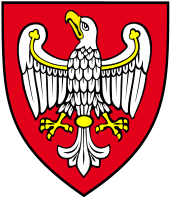Duchy of Greater Poland
The Duchy of Wielkopolska was established in the 12th century in what is now Wielkopolska after the Kingdom of Poland was divided into partial duchies in 1138 by the will of Duke Bolesław III. Crooked mouth .
Greater Poland (Polish: Wielkopolska) was originally the nucleus of the West Slavic tribe of the Polans and originally the core area of the Polish state, in the catchment area of the Warta with the main festivals of Posen and Gniezno . With the inclusion of more and more areas in the Polish state association, the need arose in the 13th century to differentiate the old tribal province of the Polans by introducing the name "Polonia Magna" in the sense of "Polonia maior" (older Poland) from the new acquisitions.
Mieszko , one of the sons of Boleslaw Schiefmund , became the first Duke of Greater Poland . He was the founder of the Greater Poland Piast line . In the second half of the 12th century the duchy succumbed to feudal particularism . As a result, three partial dominions arose around the cities of Posen, Gnesen and Kalisch , thus weakening the region politically. Due to the resulting power vacuum, the Wielkopolska duchies came under the influence of the Silesian Piasts in the first half of the 13th century until the Mongol invasion of 1241 .
All three partial dominions (duchies) were united in 1279 under Duke Przemysław . This planned an unification of the politically divided Poland under his leadership. His coronation as King of Poland in 1295 was intended to strengthen his authority and supremacy in the struggle against competing subsidiary lines of the Piast dynasty and Duke Wenceslaus of Bohemia . A year later he died as a result of a nobility conspiracy that was in alliance with the Margraves of Brandenburg and the Kingdom of Bohemia . With Przemysław, the Piast line of Greater Poland died out in the male line .
In the years between 1296 and 1314, the duchy was under various rulers until Duke Władysław I. Ellenlang finally asserted himself as sovereign in Wielkopolska from 1314.
The duchy was dissolved as a feudal rulership and in 1320 divided into two voivodships : one based in Poznan, the other in Kalisch (Palatinatus Posnaniensis and Palatinatus Calisiensis). From then on, the voivodships were among the most important administrative regions of the United Kingdom of Poland until the second partition of Poland in 1793.
After the establishment of the First Polish Republic in 1569, a large province called Greater Poland was created, which in addition to the eponymous landscape also included Mazovia and Royal Prussia .
See also
Remarks
- ↑ Kujawien and Dobrin were occupied by the Teutonic Order at that time and only finally fell to Poland with the Peace of Kalisch in 1343.

